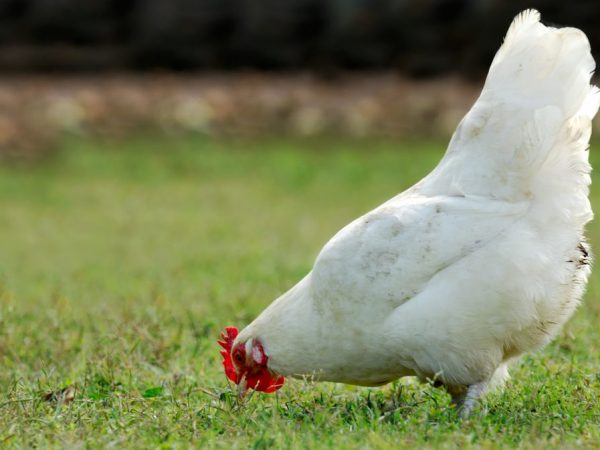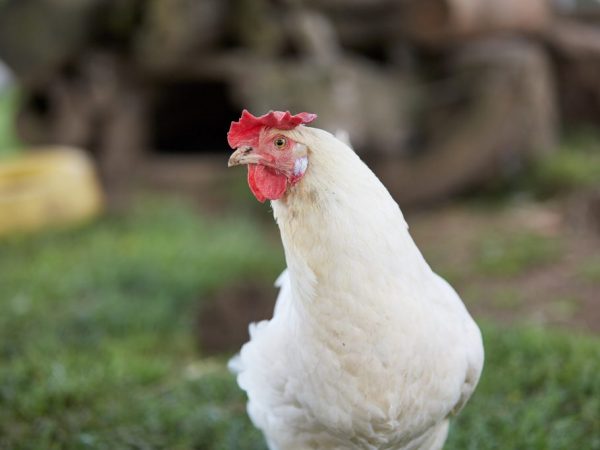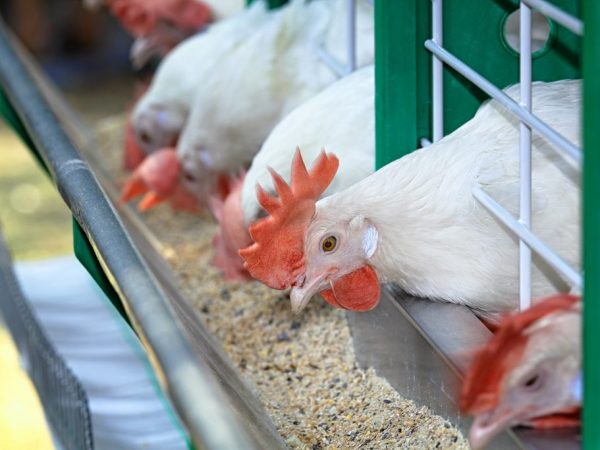Breed of chickens Russian white
Popular among breeders, the Russian White breed of chickens was bred on the basis of Leghorns and layers. To instill in the bird good resistance to harsh climatic conditions, it was crossed with native chickens. The result is a livestock with good egg production and excellent immunity.

Breed of chickens Russian white
Features of the breed
The description of the breed includes several qualities:
- large, like in Leghorns, leaf-like crest, slightly hanging to one side, in roosters - erect, consists of 5 teeth;
- the head is medium in size, rounded;
- red eyes;
- earlobes are white, thickened;
- the neck is not too long, thick;
- the chest is wide, rounded;
- the tail is small, in relation to the back is located at an angle of 90 °;
- legs are stocky, light yellow.
The plumage is exceptionally white, without any transitions to other shades.
Where could I buy
You can buy this breed in several places in our country - Adler, Maryinskaya poultry factories, Mashuk, Pushkin gene pool in St. Petersburg and VNITIP in Moscow.
The price for one hatching egg in the Pushkin gene pool is 90, in VNITIP - 30 rubles per 1 piece. The average cost of young stock at poultry farms varies from 400 to 500 rubles.
Character
Russian white chickens have a calmer and more peaceful character. They easily endure stressful situations - transportation to another area or relocation to a new chicken coop, without reducing productivity indicators.
Roosters do not show aggression towards people, only if there is a clear danger, they become real defenders of the herd.
Productivity
The chicken does not differ in large weight - in adulthood it weighs 1.8-2.4, the rooster is about 3 kg.
The breed is bred to produce a large number of delicious eggs. For a year, one individual can lay from 200 to 250 eggs, some up to 300 eggs.
The shell is white, the average weight is 55-60 g, sometimes 65 g. Laying hens begin their first clutch at the age of five months.
The fertility of the laid eggs is about 95%, the survival rate of chickens is 92-94%. Chicks grow well, quickly gain weight and are unpretentious in keeping and feeding conditions.
Molt and break of egg production
From 48 weeks of age, laying hens reduce productivity - they produce fewer eggs, but larger ones. For 4 or 5 years of cultivation, they are sent for slaughter and replaced by young individuals.

Birds molt in the spring
Chickens molt every year - usually in the spring. Changing the feather cover has a positive effect on their health and lasts a long time (about 3-4 months). During this period, the bird stops rushing.
To speed up the moulting process and help hens recover faster, the breeder needs to provide optimal housing conditions.
- Balanced feeding with increased protein and low calcium in the main diet. Such nutrition increases the intensity of feather growth.
- Chickens that are moulting are best kept separate from the general herd, because there is a high risk of injury to bare integuments.
- Birds are provided with warmth, cleanliness in the chicken coop and daily fresh water, vitamins are added to the main feed.
Incubation instinct
The incubation instinct is poorly developed, so eggs are thrown under another hen or an incubator is used for breeding chicks.
Experienced breeders do not advise using layers of this breed for breeding offspring - as practice shows, chickens grow wild and do not adapt well to keeping in a backyard.
Advantages and disadvantages
Many breeders refused to breed Russian white chickens, preferring foreign breeding with high productivity.
But, as practice shows, in regions with severe winters and changeable weather, this breed remains the most resistant and ideal for reproduction.
The characteristics of the livestock include several advantages:
- good performance indicators;
- great taste of meat and eggs;
- good health and non-susceptibility to neoplasia - thanks to these qualities, the breed is bred not only in private, but also large farms;
- they do not need a special diet for full growth and productivity.
There is only one drawback - it is difficult to find purebred chickens for further reproduction.
Breeding rules
To get strong offspring, you need to use eggs from healthy layers that live in the same flock with roosters.
Fresh specimens are taken - no older than 5 days. They should be of medium size, not too elongated or flattened, so that the chicks hatch without defects and develop fully. The surface should be flat, smooth, without cracks.
They are placed in an incubator, the temperature is set at 40 ° C, after a week it is lowered by 1 ° C, this process is repeated every 7 days.
Until the chicks appear, it is important to ensure uniform heating of the eggs, so they are turned over several times a day.
Care and feeding
The chicks that appear are transferred to a warm box made of cardboard or wood, covered with sawdust and straw.
To quickly dry the gun, set the temperature within 23-25 ° C and bright diffused lighting using artificial light lamps. The optimal duration of the LED is 22 hours.
The first time food is offered to chicks after they dry out and activate. They give a finely chopped boiled chicken egg. Starting from the third day, chopped green onions are additionally included in the diet.
After a week, you can give cereals, low-fat cottage cheese, continue to feed the egg and onion feathers.

Three-month-old individuals can be transferred to a common flock
A glucose solution is served as a drink - 50 g of the substance is diluted in 1 liter of warm water. After 3 days, they drink plain warm water.
Up to 2 months of age, chickens are fed often - 3-4 times a day without limiting the amount of feed. Grown up individuals at the age of 2.5-3 months are transferred to the general flock and to the diet of adult chickens.
To increase egg production from 12 weeks, the feed rate for laying hens is reduced.
Keeping an adult bird
White chickens do not differ in whimsical care and maintenance, but by providing them with the proper conditions for growth and development, you can achieve good productivity, as well as raise a healthy tribe.
Chicken coop
This is the main habitat for chickens and roosters, especially in the winter season, so it must be equipped in accordance with the requirements for keeping poultry.
- It should be spacious - 1 m³ for one individual.
- The optimum temperature in winter is 23-25 ° C, in summer 12-13 ° C.
- Humidity at the level of 50-55%. This indicator can be achieved by daily ventilation of the room through doors or windows.
- The floor surface must be warm and clean. First, it is tightened with sheets of tin to avoid the invasion of rodents into the chicken coop.It is then covered with a thick layer of slaked lime to help prevent fungal infections. From above, the floor is covered with sawdust, dried peat or straw. The flooring is laid on a dry and sunny day, because in damp weather it will saturate moisture, rot and can cause various diseases. Litter change is carried out at least once a year.
- Additionally, the walls of the hen house are treated - they are whitewashed with slaked lime. This substance destroys all pathogenic bacteria and microbes on the surface. After processing, the room is ventilated, the birds are launched after 10 days.
- The chicken coop must be equipped with lighting. As practice shows, the dim light of a red or blue lamp is excellent. With this kind of lighting, the hens do not show aggression and rush well.
- For the convenience of the birds, perches with a height of about 50 cm are installed. Nests are also attached for each hen in a quiet and calm place.
- Equip feeders and drinking containers. After each feeding, they are cleaned, and the drinkers, if they are open, are washed. Some breeders use nipple or groove designs for convenience, which do not need to be cleaned frequently. The water in them remains fresh for several days.
Feeding ration
Nutrition and feeding norms of the Russian White breed.
- The basis is compound feed - 120 g per individual.
- In winter, grass flour is added to the feed, chopped oats, wheat, barley, peas are offered. To increase productivity and maintain health, layers are given sprouted cereals. Additionally, feeders are installed with shells and pieces of chalk. Meat and bone or fish meal is added to the main feed. All these components increase the calcium content in the body, have a beneficial effect on the immune system and the quality of eggs.
- In the summer, the bird loves to eat grass, shells, insects in the courtyard.
- Additionally, throughout the year, mash mixtures of boiled and grated potatoes, other vegetables and fruits are added to the diet.
Place for walking
The characteristics of the breed include a calm and peaceful character, so chickens do not need to equip a special enclosure covered with a net. It is enough to make a fence about 100 cm high so that the birds do not leave the yard.
The more space to walk, the better your health and productivity will be.
In the spring, the site is sown with cereals so that there is fresh greens by the summer. Also, the place for the walk is sprinkled with shell rock with the addition of pieces of chalk. These components will eliminate calcium deficiency.
In autumn, the aviary can be covered with a roof, so the birds can walk into the fresh air in the cold season and remove the remains of food under a cover of snow.
Possible diseases
This breed has high immunity against diseases, however, for prevention, experienced breeders recommend several simple and important measures:
- vaccination of chickens at an early age;
- selection of high-quality, medium-sized and defect-free eggs for incubation;
- strict adherence to the temperature regime in the incubator;
- keeping chicks and young growth in a warm, dry, and well-ventilated area;
- avoid crowding of birds, as this can lead to the development of various pathologies and diseases;
- provide chickens with a full-fledged diet throughout the year with the addition of vitamins, minerals, greens.
Gardeners reviews
According to experienced farmers, the Russian White Chicken is a real boon for beginners.
The breed is not demanding in nutrition and keeping conditions, while it is distinguished by good performance indicators.
Many prefer her because of her calm nature, which allows her to keep chickens in a common courtyard.
Others were interested in the excellent egg production, which makes it possible to get a large number of eggs for sale.


